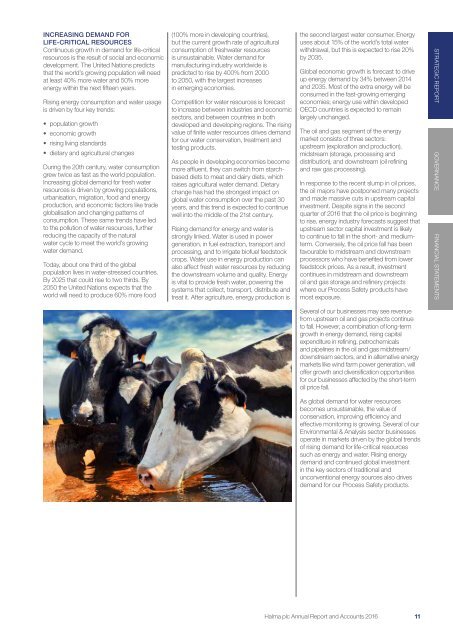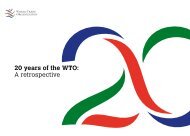Create successful ePaper yourself
Turn your PDF publications into a flip-book with our unique Google optimized e-Paper software.
INCREASING DEMAND FOR<br />
LIFE-CRITICAL RESOURCES<br />
Continuous growth in demand for life-critical<br />
resources is the result of social and economic<br />
development. The United Nations predicts<br />
that the world’s growing population will need<br />
at least 40% more water and 50% more<br />
energy within the next fifteen years.<br />
Rising energy consumption and water usage<br />
is driven by four key trends:<br />
• population growth<br />
• economic growth<br />
• rising living standards<br />
• dietary and agricultural changes<br />
During the 20th century, water consumption<br />
grew twice as fast as the world population.<br />
Increasing global demand for fresh water<br />
resources is driven by growing populations,<br />
urbanisation, migration, food and energy<br />
production, and economic factors like trade<br />
globalisation and changing patterns of<br />
consumption. These same trends have led<br />
to the pollution of water resources, further<br />
reducing the capacity of the natural<br />
water cycle to meet the world’s growing<br />
water demand.<br />
Today, about one third of the global<br />
population lives in water-stressed countries.<br />
By 2025 that could rise to two thirds. By<br />
2050 the United Nations expects that the<br />
world will need to produce 60% more food<br />
(100% more in developing countries),<br />
but the current growth rate of agricultural<br />
consumption of freshwater resources<br />
is unsustainable. Water demand for<br />
manufacturing industry worldwide is<br />
predicted to rise by 400% from 2000<br />
to 2050, with the largest increases<br />
in emerging economies.<br />
Competition for water resources is forecast<br />
to increase between industries and economic<br />
sectors, and between countries in both<br />
developed and developing regions. The rising<br />
value of finite water resources drives demand<br />
for our water conservation, treatment and<br />
testing products.<br />
As people in developing economies become<br />
more affluent, they can switch from starchbased<br />
diets to meat and dairy diets, which<br />
raises agricultural water demand. Dietary<br />
change has had the strongest impact on<br />
global water consumption over the past 30<br />
years, and this trend is expected to continue<br />
well into the middle of the 21st century.<br />
Rising demand for energy and water is<br />
strongly linked. Water is used in power<br />
generation, in fuel extraction, transport and<br />
processing, and to irrigate biofuel feedstock<br />
crops. Water use in energy production can<br />
also affect fresh water resources by reducing<br />
the downstream volume and quality. Energy<br />
is vital to provide fresh water, powering the<br />
systems that collect, transport, distribute and<br />
treat it. After agriculture, energy production is<br />
the second largest water consumer. Energy<br />
uses about 15% of the world’s total water<br />
withdrawal, but this is expected to rise 20%<br />
by 2035.<br />
Global economic growth is forecast to drive<br />
up energy demand by 34% between 2014<br />
and 2035. Most of the extra energy will be<br />
consumed in the fast-growing emerging<br />
economies; energy use within developed<br />
OECD countries is expected to remain<br />
largely unchanged.<br />
The oil and gas segment of the energy<br />
market consists of three sectors:<br />
upstream (exploration and production),<br />
midstream (storage, processing and<br />
distribution), and downstream (oil refining<br />
and raw gas processing).<br />
In response to the recent slump in oil prices,<br />
the oil majors have postponed many projects<br />
and made massive cuts in upstream capital<br />
investment. Despite signs in the second<br />
quarter of <strong>2016</strong> that the oil price is beginning<br />
to rise, energy industry forecasts suggest that<br />
upstream sector capital investment is likely<br />
to continue to fall in the short- and mediumterm.<br />
Conversely, the oil price fall has been<br />
favourable to midstream and downstream<br />
processors who have benefited from lower<br />
feedstock prices. As a result, investment<br />
continues in midstream and downstream<br />
oil and gas storage and refinery projects<br />
where our Process Safety products have<br />
most exposure.<br />
STRATEGIC REPORT GOVERNANCE FINANCIAL STATEMENTS<br />
Several of our businesses may see revenue<br />
from upstream oil and gas projects continue<br />
to fall. However, a combination of long-term<br />
growth in energy demand, rising capital<br />
expenditure in refining, petrochemicals<br />
and pipelines in the oil and gas midstream/<br />
downstream sectors, and in alternative energy<br />
markets like wind farm power generation, will<br />
offer growth and diversification opportunities<br />
for our businesses affected by the short-term<br />
oil price fall.<br />
As global demand for water resources<br />
becomes unsustainable, the value of<br />
conservation, improving efficiency and<br />
effective monitoring is growing. Several of our<br />
Environmental & Analysis sector businesses<br />
operate in markets driven by the global trends<br />
of rising demand for life-critical resources<br />
such as energy and water. Rising energy<br />
demand and continued global investment<br />
in the key sectors of traditional and<br />
unconventional energy sources also drives<br />
demand for our Process Safety products.<br />
<strong>Halma</strong> plc Annual Report and Accounts <strong>2016</strong> 11

















